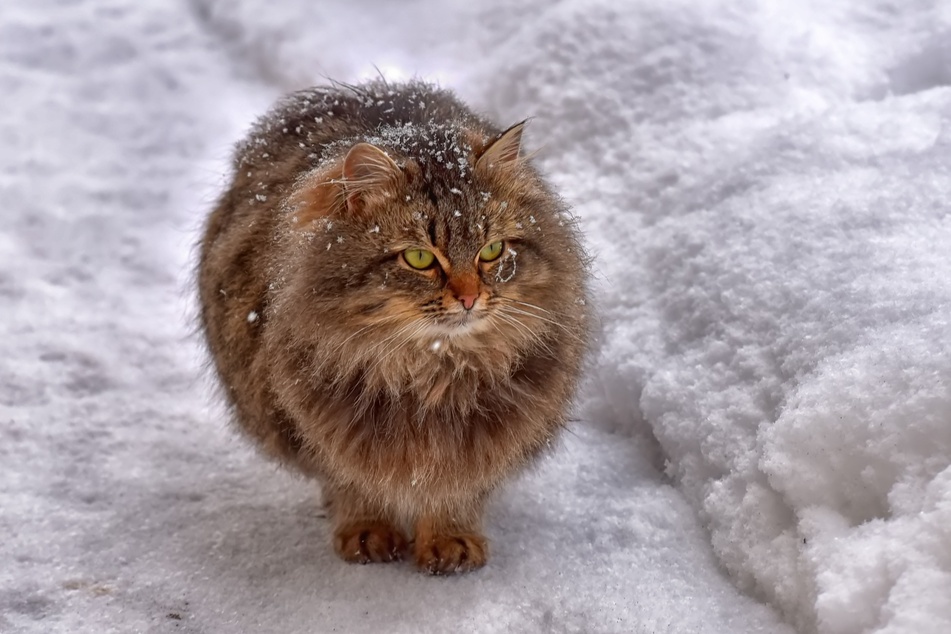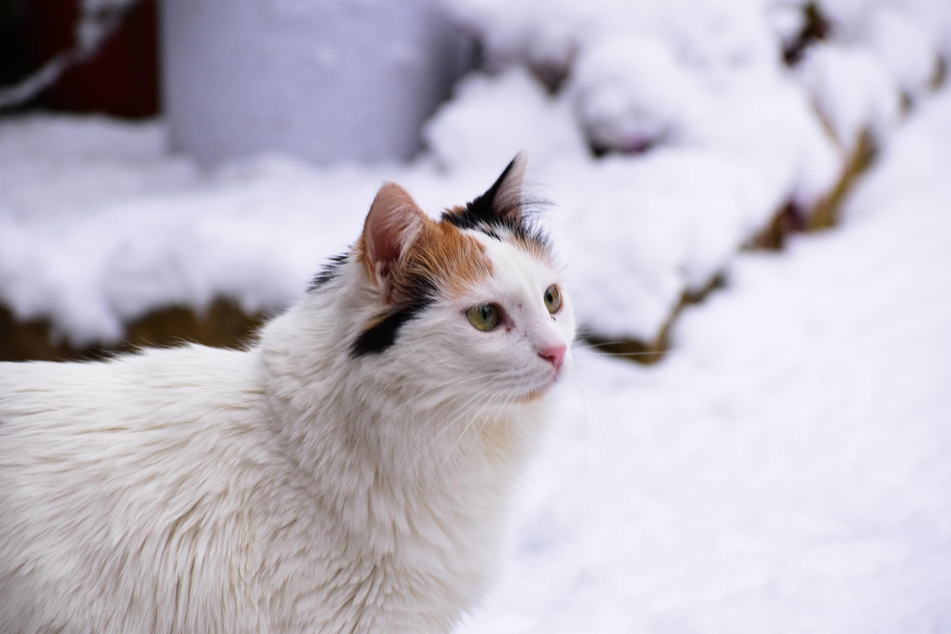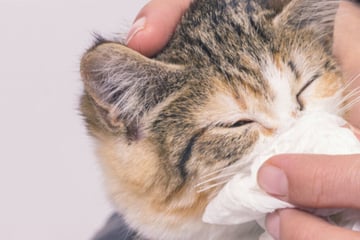Do cats get cold? Hypothermia in cats and symptoms of a cold
What happens to our feline friends in winter? Do cats get cold easily, or is their fur thick and warm enough to protect them against hypothermia? Let's take a look at some that's something might be wrong, some explanations, and ways to help out a brrrr-ing cat!

As it gets colder and gloomier outside, we humans have many ways to keep warm as the ice sets in – even in the midst of blizzards and huge winter storms.
Cats are different. They can't put on a nice warm jumper, and soup isn't exactly their thing.
So how do they stay warm and protected against the cold? Is their fur enough or could they use a helping hand wrapping up?
TAG24 cat guide will take you through everything you need to know to keep your furry friend nice and snuggly. Can cats get cold, what's the deal with hypothermia, and what symptoms should you look out for?
Do cats get cold easily?
Cats get cold like everyone else, in winter, autumn, summer, and spring. Sure, with that thick coat of fur they don during summer months, it's a lot harder for them to freeze than it would be for a human, but they're not invincible and they can still get sick.
Older and immunocompromised cats, for example, are particularly vulnerable to the cold and should not be let outside when the temperature is low enough to threaten their life. This also goes for cats that have recently undergone surgery or have developed a health condition.
What temperature do cats get cold at?
In an interview with Daily Paws, Dr. Michael Arpino from Veterinary Wellness Center of Boerum Hill in Brooklyn recommended that a cat should not live in a space that is consistently below 45 degrees Fahrenheit, and should never spend extended periods below freezing point.
The dangers posed by spending extended periods in sub-zero temperatures are pretty self-evident, including hypothermia and even death. When it comes to temperatures below 45, though, extended exposure will create a susceptibility to health issues that may not lead to death, but could cause serious illness.
How do cats regulate their body temperature?

Cats go through periods of shedding and growing, putting on and taking away fur multiple times a year. It is, in essence, a seasonal activity that has many a consequence. From fur balls caused by grooming, to the need to eat cat grass, this inconvenience does have one key role: body temperature regulation.
As warm-blooded animals, cats maintain a core body temperature that is required for the normal functioning of their bodies. This temperature should be between 99.5 and 102 degrees Fahrenheit, and there are a number of factors involved in its regulation. If their temperature dips lower than this, they are at risk of hypothermia.
Other than shedding, here are some other ways cats regulate their body temperatures:
- Cat sweat plays a small cooling role.
- Some cats like to swim to cool down.
- Cats lick themselves to make their fur damp and cool down.
- Similar to dogs, cats actually pant and stick their tongue out.
- Squeezing up very tightly in cold weather, and laying out flat and large in hot weather.
Keep in mind: A cat's main method of keeping their core temperature up when they are in the cold is via their thick and warm fur. If your cat has very little fur, then you should make sure not to allow it outside in sub-zero temperatures.
How to tell if your cat is cold: Symptoms
Cats will show a variety of symptoms when they get cold, many of which are quite similar to those experienced by humans. If you notice that your feline friend is feeling really, really cold, then you should make sure to pay attention to these symptoms and look after it.
Here are a number of cold cat symptoms to look out for:
- Your cat continuously looks for warm places like in front of the heater, near the fireplace, or in direct sunlight.
- The cat is cold to the touch, and you can feel that its ears, paws, and the tip of its tail is particularly cool.
- When a house cat lies curled up tightly in a ball and puffs up its fur, it is likely trying to retain as much heat as possible.
- If your cat is shivering violently and showing clear signs of being cold, similar to those displayed by humans.
- In the case that your cat's mucous membrane – gums and such – is pale or bluish, it is likely that they are suffering quite severely. You should take it immediately to the veterinarian.
Keep in mind: If your cat's body temperature dips below 100 degrees Fahrenheit, then you should take it immediately to the vet and keep it warm. This can cause very serious health problems, including hypothermia.
How to measure a cat's temperature
If you are concerned that your cat is far too cold, it is a good idea to measure its temperature. Doing this will allow you to determine how cold your cat is, whether it is in any danger, and what actions you should take. We would recommend taking these steps with the help of a second person.
Here is how to take a cat's temperature:
- Step 1: Get a thermometer from your vet that is specifically designed for measuring a cat's temperature.
- Step 2: This thermometer should be inserted rectally, as a cat's mouth and ears are unsuitable for the task.
- Step 3: Use a greasy cream, also supplied by the vet, to make the device slippery, and then insert it.
- Step 4: Wait until it has finished measuring (usually indicated by a beep), remove it, and read the temperature.
Most digital clinical thermometers are perfectly adequate for this task, but you should buy one to be exclusively used for your cat.

When do cats get cold?
Our fluffy little feline friends can be at risk of getting cold or developing hypothermia if they are in sub-zero temperatures, no matter the location. This means that cats can get cold inside and outside, they can get cold in the winter, in the house, and anywhere that has the potential to reduce their core temperature below 100 Fahrenheit.
The riskiest time of year is, of course, winter, but that doesn't mean that a cat cannot get cold at other times of the year. In autumn especially, and in early Spring, they can still develop severe cold if exposed to the elements for too long. The lesson in all of this? Well, it's quite simple: pay attention to your pet's needs.
Hypothermia in cats
Hypothermia is defined, according to the CDC, as "abnormally low body temperature" that occurs when an individual, human or animal, is "exposed to extremely cold temperatures". It is a medical emergency that needs to be acted upon immediately, and taken very seriously.
Symptoms of hypothermia in cats can include:
- Severe shivering
- Confusion
- Lethargy and listlessness
- Incredibly clumsiness
- Paleness of the skin
- Discoloration of the mouth, ears, and anal area
- Comatose
Risk factors particularly include if a cat is wet and outside in sub-zero temperatures, or long-term exposure to extremely cold weather.
How do I help when my cat is cold or hypothermic?

Cats that show symptoms of being severely cold or almost hypothermic should be treated as having a medical emergency, and looked at quickly. This care needs to come in two stages, immediate and follow-up care, neither of which should be ignored.
Here's how to treat a cat who's showing signs of hypothermia or extreme cold:
- Immediately remove the cat from the cold environment, picking it up and carefully taking it inside or into a warm car (if it is a stray or unknown cat).
- If the cat is wet, then it first needs to be dried well with a towel, so that it is no longer soaking in icy water.
- Use items like blankets, hot water bottles, and clothing to warm the cat up as quickly as possible.
- Check your cat's temperature as described above to define the extent to which this is a medical emergency.
- Offer your cat some warm (not hot) water to drink, to help increase its internal temperature.
- Seek immediate medical attention from your veterinarian.
Caution: Make sure that none of your aids, especially the hot water bottle, are too hot. You don't want to accidentally burn your kitty!
Cats aren't invincible! Keep them warm!
If you keep your cat nice, healthy, and strong, then it will do well outdoors even in sub-zero temperatures. Their dense fur will protect them from the cold, but that doesn't make them invincible against the cold. Indeed, in the case that their fur gets wet, hypothermia and other cold-related problems could become a real danger.
If your cat is chilled to its bones, you should take it seriously. Cold cats might look pretty cute, all fluffed up and rolled into a ball, but it is always good to stay safe in winter by measuring their temperature, and taking them to the vet if they get sick.
Cover photo: Mathias Reding / Unsplash




